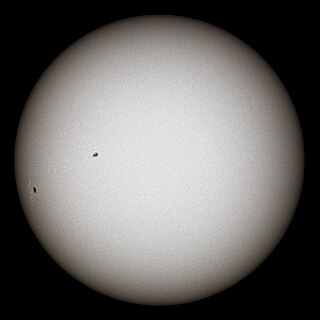
Nuclear fusion is a reaction in which two or more atomic nuclei, combine to form one or more atomic nuclei and neutrons. The difference in mass between the reactants and products is manifested as either the release or absorption of energy. This difference in mass arises as a result of the difference in nuclear binding energy between the atomic nuclei before and after the fusion reaction. Nuclear fusion is the process that powers active or main-sequence stars and other high-magnitude stars, where large amounts of energy are released.
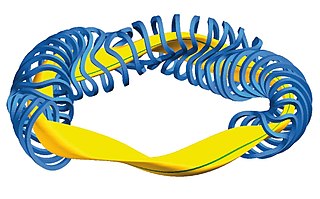
A stellarator confines plasma using external magnets. Scientists aim to use stellarators to generate fusion power. It is one of many types of magnetic confinement fusion devices, most commonly tokamak. The name "stellarator" refers to stars because fusion mostly occurs in stars such as the Sun. It is one of the earliest human-designed fusion power devices.
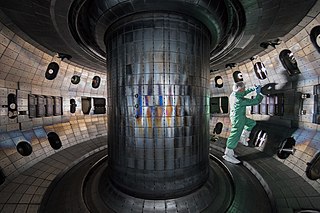
A tokamak is a device which uses a powerful magnetic field generated by external magnets to confine plasma in the shape of an axially symmetrical torus. The tokamak is one of several types of magnetic confinement devices being developed to produce controlled thermonuclear fusion power. The tokamak concept is currently one of the leading candidates for a practical fusion reactor.

Princeton Plasma Physics Laboratory (PPPL) is a United States Department of Energy national laboratory for plasma physics and nuclear fusion science. Its primary mission is research into and development of fusion as an energy source. It is known for the development of the stellarator and tokamak designs, along with numerous fundamental advances in plasma physics and the exploration of many other plasma confinement concepts.

Fusion power is a proposed form of power generation that would generate electricity by using heat from nuclear fusion reactions. In a fusion process, two lighter atomic nuclei combine to form a heavier nucleus, while releasing energy. Devices designed to harness this energy are known as fusion reactors. Research into fusion reactors began in the 1940s, but as of 2024, no device has reached net power, although net positive reactions have been achieved.
This timeline of nuclear fusion is an incomplete chronological summary of significant events in the study and use of nuclear fusion.

The Joint European Torus (JET) was a magnetically confined plasma physics experiment, located at Culham Centre for Fusion Energy in Oxfordshire, UK. Based on a tokamak design, the fusion research facility was a joint European project with the main purpose of opening the way to future nuclear fusion grid energy. At the time of its design JET was larger than any comparable machine.
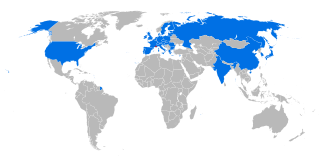
ITER is an international nuclear fusion research and engineering megaproject aimed at creating energy through a fusion process similar to that of the Sun. It is being built next to the Cadarache facility in southern France. Upon completion of construction of the main reactor and first plasma, planned for 2033–2034, ITER will be the largest of more than 100 fusion reactors built since the 1950s, with six times the plasma volume of JT-60SA in Japan, the largest tokamak operating today.

The T-15 is a Russian nuclear fusion research reactor located at the Kurchatov Institute, which is based on the (Soviet-invented) tokamak design. It was the first industrial prototype fusion reactor to use superconducting magnets to control the plasma. These enormous superconducting magnets confined the plasma the reactor produced, but failed to sustain it for more than just a few seconds. Despite not being immediately applicable, this new technological advancement proved to the USSR that they were on the right path. In the original shape, a toroidal chamber design, it had a major radius of 2.43 m and minor radius 0.7 m.

The Tokamak Fusion Test Reactor (TFTR) was an experimental tokamak built at Princeton Plasma Physics Laboratory (PPPL) circa 1980 and entering service in 1982. TFTR was designed with the explicit goal of reaching scientific breakeven, the point where the heat being released from the fusion reactions in the plasma is equal or greater than the heating being supplied to the plasma by external devices to warm it up.
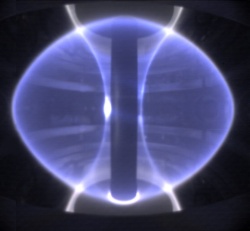
Magnetic confinement fusion (MCF) is an approach to generate thermonuclear fusion power that uses magnetic fields to confine fusion fuel in the form of a plasma. Magnetic confinement is one of two major branches of controlled fusion research, along with inertial confinement fusion.
The beta of a plasma, symbolized by β, is the ratio of the plasma pressure (p = nkBT) to the magnetic pressure (pmag = B2/2μ0). The term is commonly used in studies of the Sun and Earth's magnetic field, and in the field of fusion power designs.
Migma, sometimes migmatron or migmacell, was a proposed colliding beam fusion reactor designed by Bogdan Maglich in 1969. Migma uses self-intersecting beams of ions from small particle accelerators to force the ions to fuse. Similar systems using larger collections of particles, up to microscopic dust sized, were referred to as "macrons". Migma was an area of some research in the 1970s and early 1980s, but lack of funding precluded further development.
Bernard J. Eastlund was an American physicist who received his B.S. in physics from Massachusetts Institute of Technology (MIT) and his Ph.D. in physics from Columbia University. In 1970 he received a Special Achievement Certificate from the U. S. Atomic Energy Commission for co-invention of the "fusion torch."
Hybrid nuclear fusion–fission is a proposed means of generating power by use of a combination of nuclear fusion and fission processes.

A spherical tokamak is a type of fusion power device based on the tokamak principle. It is notable for its very narrow profile, or aspect ratio. A traditional tokamak has a toroidal confinement area that gives it an overall shape similar to a donut, complete with a large hole in the middle. The spherical tokamak reduces the size of the hole as much as possible, resulting in a plasma shape that is almost spherical, often compared to a cored apple. The spherical tokamak is sometimes referred to as a spherical torus and often shortened to ST.
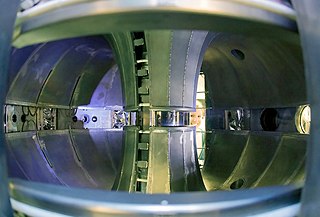
The Lithium Tokamak Experiment (LTX), and its predecessor, the Current Drive Experiment-Upgrade (CDX-U), are devices dedicated to the study of liquid lithium as a plasma-facing component (PFC) at Princeton Plasma Physics Laboratory.

The Tandem Mirror Experiment was a magnetic mirror machine operated from 1979 to 1987 at the Lawrence Livermore National Laboratory. It was the first large-scale machine to test the "tandem mirror" concept in which two mirrors trapped a large volume of plasma between them in an effort to increase the efficiency of the reactor.

The Princeton Large Torus, was an early tokamak built at the Princeton Plasma Physics Laboratory (PPPL). It was one of the first large scale tokamak machines and among the most powerful in terms of current and magnetic fields. Originally built to demonstrate that larger devices would have better confinement times, it was later modified to perform heating of the plasma fuel, a requirement of any practical fusion power device.
The history of nuclear fusion began early in the 20th century as an inquiry into how stars powered themselves and expanded to incorporate a broad inquiry into the nature of matter and energy, as potential applications expanded to include warfare, energy production and rocket propulsion.












